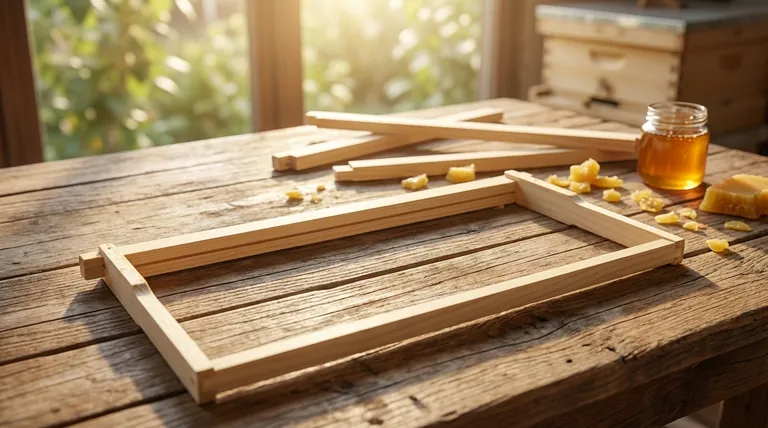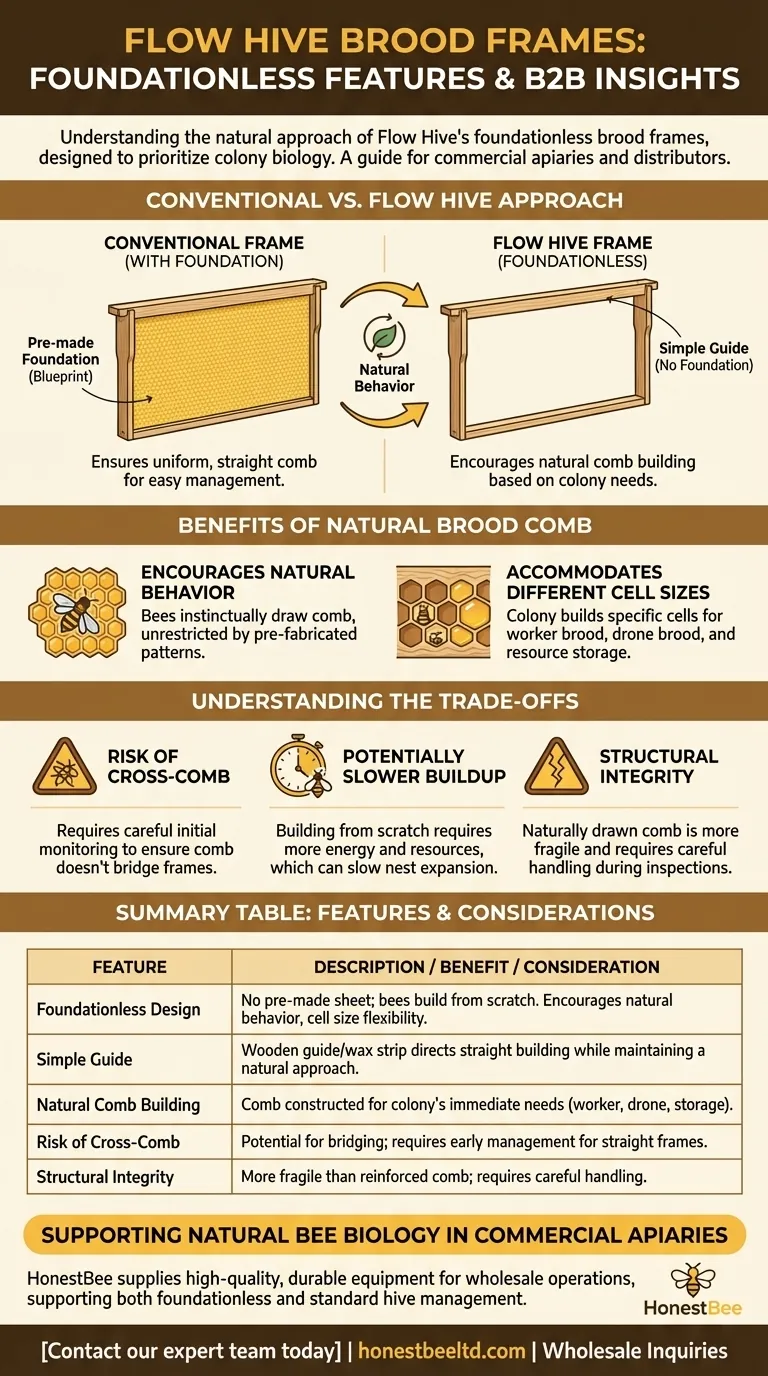The defining feature of Flow Hive brood frames is that they are foundationless. This means they do not come with a pre-made sheet of wax or plastic foundation, instead providing the bees with an empty frame and a simple guide to encourage them to build their own natural comb from scratch.
The core principle behind the Flow Hive's foundationless brood frames is to separate the hive's functions: while the honey super is optimized for harvesting, the brood box is designed to let the bees build their home as naturally as possible.

What "Foundationless" Means for Your Colony
To understand the Flow Hive's approach, it's essential to compare it to the conventional method used in most beehives.
The Conventional Approach: Foundation
Most beekeeping frames include a "foundation"—a thin sheet of pre-formed beeswax or plastic embossed with the hexagonal pattern of honeycomb.
This foundation acts as a blueprint, giving the bees a head start and ensuring they build straight, uniform comb that is easy for the beekeeper to inspect and manage.
The Flow Hive Approach: A Natural Guide
Flow Hive brood frames are intentionally left empty. They typically include only a small wooden guide or a thin strip of beeswax along the top bar.
This minimalist design encourages bees to perform one of their most fundamental behaviors: drawing out their own comb based on the colony's immediate needs.
The Benefits of a Natural Brood Comb
Allowing bees to build their own comb in the brood chamber has several key advantages that align with a more natural beekeeping philosophy.
Encourages Natural Bee Behavior
Building comb is an instinctual part of the honeybee life cycle. Foundationless frames allow the bees to express this natural behavior without the constraints of a pre-fabricated pattern.
Accommodates Different Cell Sizes
A colony requires different sized cells for various purposes. The bees will build smaller cells for worker brood, larger cells for drone brood, and specially adapted cells for storing honey and pollen.
Foundationless frames give the colony the flexibility to build the exact size and type of cells it needs, where it needs them. This is something a uniform foundation sheet cannot offer.
Understanding the Trade-offs
While foundationless frames offer benefits, they also come with specific responsibilities and potential challenges for the beekeeper.
The Risk of Cross-Comb
The biggest challenge with foundationless frames is "cross-comb," where bees build comb that connects across multiple frames instead of staying within a single one.
This can make hive inspections difficult or impossible without damaging the comb and potentially harming the queen. Careful monitoring is required as the bees first draw out the comb to ensure it remains straight.
Potentially Slower Buildup
Building comb from scratch requires a significant amount of energy and resources (nectar) from the bees. A colony on foundationless frames may build up its brood nest more slowly than a colony given the head start of a foundation sheet.
Structural Integrity
Naturally drawn comb can be more fragile than comb reinforced with a plastic foundation sheet. Beekeepers must handle these frames with extra care during inspections, especially in hot weather when the wax is softer.
Applying This to Your Beekeeping
Your approach to managing foundationless brood frames depends entirely on your goals for the hive.
- If your primary focus is natural beekeeping: Embrace the foundationless design, as it allows the bees to control their brood nest's structure and cell size, closely mimicking a wild hive.
- If your primary focus is easy inspections and management: Be vigilant during the initial comb-building phase to correct any cross-comb early, ensuring your frames remain straight and manageable for the long term.
Ultimately, the Flow Hive's foundationless brood frames are a deliberate choice to prioritize the natural biology of the bee colony in the heart of the hive.
Summary Table:
| Feature | Description | Benefit / Consideration |
|---|---|---|
| Foundationless Design | No pre-made wax or plastic sheet; bees build comb from scratch. | Encourages natural bee behavior and accommodates different cell sizes. |
| Simple Guide | A small wooden guide or wax strip on the top bar. | Directs bees to build straight comb while maintaining a natural approach. |
| Natural Comb Building | Bees construct comb based on the colony's immediate needs. | Allows for worker brood, drone brood, and storage cells as needed. |
| Risk of Cross-Comb | Comb may bridge between frames if not monitored. | Requires careful initial management to ensure straight, inspectable frames. |
| Structural Integrity | Naturally drawn comb is more fragile than foundation-reinforced comb. | Frames require careful handling, especially in warm weather. |
Ready to build a hive that supports natural bee biology?
At HONESTBEE, we supply commercial apiaries and beekeeping equipment distributors with the high-quality, durable supplies needed to succeed. Whether you're managing foundationless frames or standard equipment, our wholesale-focused operations ensure you get the reliable gear your business depends on.
Contact our expert team today to discuss your wholesale needs and discover how we can support your beekeeping success.
Visual Guide

Related Products
- Wooden Bee Hive Frames for Beekeeping and Wholesale
- Langstroth Honey Bee Box Hive Boxes for Different Depths
- Australian Langstroth Beehive Boxes for Beekeeping Wholesales
- 5 Frame Wooden Nuc Box for Beekeeping
- Portable Bee Mating Hive Boxes Mini Mating Nucs 8 Frames for Queen Rearing
People Also Ask
- What color options are available for plastic frames, and what is the benefit of black frames? Boost Your Hive Inspection Efficiency
- Will honey bees clean up old frames? A Guide to Safe and Efficient Frame Reuse
- What are the standard sizes of frames used in Langstroth hives? Choose the Right Frame for Your Apiary
- What types of beehive frames are compatible with the honey press? A Guide to Crush-and-Strain Extraction
- What is the role of oxalic acid in plants? A Key to Plant Defense and Internal Regulation



















